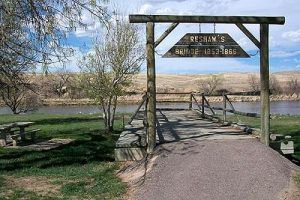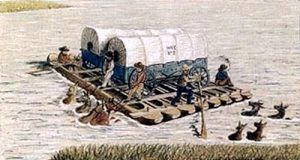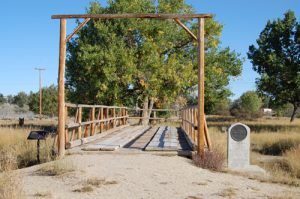Fort Clay, also known as Camp Davis, was established in 1855 to protect the Reshaw Bridge traffic in present-day Evansville, Wyoming (a suburb of Casper.)
For years, emigrants along the California–Oregon and Mormon Trails had crossed the Platte River from the south side to the north side at various points. One of the most popular crossings was located just east of modern-day Casper, Wyoming, at a place called the Old Indian Ford.
In 1847, Mormon church leader, Brigham Young, commissioned a ferry at the site where Fort Caspar would later be built. The ferry, which took about five minutes to cross the river, was free for church members, but any immigrant could use it for a fee. In 1849, the Mormons moved the ferry a few miles east, where they also operated a store where trail travelers could buy supplies. That year saw the greatest traffic volume on the trails due to the California Gold Rush.
Not everyone could afford to use the Mormon Ferry, and those who couldn’t cross the Platte River on the Old Indian Ford, which then became known as the California Crossing.
In the fall of 1852, French trader John Baptiste Richard established a trading post several miles downriver of the crossing. Taking advantage of the traffic along the trails, began to build a bridge a little bit east of the Mormon Ferry. In partnership with Joseph Bissonette, Seth Ward, William Guerrier, Charles Bordeaux, Louis Guinard, and William Kenceleur, it was the first successful bridge to span the North Platte River. The bridge opened in 1853, and that year, traffic along the trails peaked when some 50,000 emigrants used the bridge. In the beginning, the bridge was simply known as the Platte Bridge. But, as John Richard spoke with a thick French accent, most travelers of the day mistook the pronunciation of his name, thinking it was Reshaw. As a result, the bridge became widely known as Reshaw’s Bridge. Richard’s bridge put the Mormon Ferry out of business.
The U.S. Army established its first presence in the area in 1855 by erecting Fort Clay, an outpost of Fort Laramie, near Richard’s trading post. Lieutenant Deschler and members of the 6th Infantry, 10th Infantry, and 4th Artillery staffed Fort Clay in November 1855. The soldiers were tasked with protecting the bridge from Indian attacks. By the next year, the military unit had grown to a full company with three officers and a bugler. The post was renamed Camp Davis in February 1856 in honor of Jefferson Davis, then President Franklin Pierce’s secretary of war and later president of the Confederacy. But, by November 1856 the Camp Davis was abandoned.
However, two years later, when the army needed to maintain a route to supply troops involved in the Mormon War, soldiers were again stationed at the site in July 1858. It was established by Captain Joseph Roberts of the 4th Artillery and called Camp Payne. This post, too, was short-lived and closed in May 1859.
That same year, Richard’s old partner, Louis Guinard, started building a newer and better bridge at the old Mormon Ferry crossing site. Completed in the spring of 1860, Guinard’s bridge and the trading post became the site of a Pony Express Station and, later, a stop of the Overland Mail Company. When the transcontinental telegraph line went through the area in 1861, it crossed the North Platte River on Guinard’s bridge, and his trading post now included a Pacific Telegraph Company Office.
At that time, Guinard’s Bridge was referred to as the Upper Platte Bridge, and Richard’s was referred to as the Lower Platte Bridge. Though Richard’s bridge suffered from competition, he diversified his interests and continued to work in the fur trade. However, with the constant threat of native hostilities and after Louis Guinard lost his son in an Indian attack, he sold the bridge to Richard by 1864.
In the meantime, U.S. troops had occupied Guinard’s buildings for three years during the Civil War and called the site Platte Bridge Station. The soldiers protected emigrants along the trails and the newly established telegraph lines against raids from Lakota and Cheyenne tribes.
By 1865, with increased native hostilities, as well as legal problems with the United States military, Richard sold his post and bridges to the military. He and his family then relocated to Rock Creek on the new Overland Trail, carrying most of the transcontinental traffic.
He was gone before the Battle of Platte Bridge occurred on July 26, 1865, between soldiers and the Indians. In the battle, the Reshaw Bridge was partially burned. Soon afterward, Fort Caspar was established at the site of Platte Bridge Station. During the severe winter of 1866-1867, soldiers at the fort dismantled Richard’s Bridge and many nearby buildings for firewood and building materials. Fort Caspar was abandoned in 1867, and almost immediately after the troops were gone, the Indians burned the buildings and the remaining bridge.
Reshaw’s Bridge has been reconstructed today and can be seen at Reshaw Park in Evansville, Wyoming.
© Kathy Alexander/Legends of America, updated November 2022.
Also See:
Jean “John” Baptiste Richard – Trader and Entrepreneur
Sources:
Fifer, Barbara; Wyoming’s Historic Forts, Farcountry Press, 2003.
Trading Posts of Wyoming National Register Nomination
Wikipedia
Wyoming History




